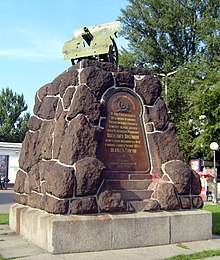Kiev arsenal factory revolt
The Kiev arsenal revolt (also January uprising or January rebellion ; Ukrainian Січневе повстання Sitschnewe powstannja ) was a revolt organized by Bolsheviks of armed workers that began on January 29, 1918 during the Ukrainian-Soviet war in Kiev through the first storming of the arsenal factory Ukrainian troops lasted on February 4, 1918.
course
The elections to the constituent assembly in Ukraine , scheduled for January 9, 1918, had to be largely postponed as a result of the Ukrainian-Soviet war , as virtually all of the left-Dnieper territories were occupied by the Russian armed forces led by Vladimir Alexandrovich Antonov-Ovsejenko . After the meeting of the members of the Ukrainian Constituent Assembly, scheduled for January 22, but only partially elected, was postponed, the Kiev Bolsheviks decided not to wait any longer and to support the penetrating Soviet troops by means of a revolt. The riots should start when Russian units advance on Kiev, thereby withdrawing Ukrainian military units from the front and binding them in the inner-city conflict. Similar action was taken in other cities such as Yekaterinoslav , Odessa , Mykolaiv and Yelisavetgrad to support the advance of the Red Army . The arsenal factory was chosen as the center of the survey. The leaders of the revolt were Jan Hamarnyk, Oleksandr Horwits, Andriy Ivanov and Isaac Kreysberg. On the same night of January 28, workers from several other factories, as well as soldiers from the Bohdaniv, Shevchenko and Sahaydachny regiments, joined the arsenal workers.
On January 29, the insurgents brought, among other things, the train station, numerous police stations and public facilities under their control. The following day the whole city was paralyzed by a general strike, utilities and public transport collapsed. The central assembly of Ukraine no longer had any influence on most of the army units, many of which refused to intervene. The Ukrainian government was only supported by individual parts of the Bohdaniv Regiment, the Polubotko Regiment and the Bohun Regiment, as well as a Kurin from Sitsch-Schützen and the Free Cossacks .
On February 1, the central assembly proclaimed that it had full control of the city and called on the workers to stop the uprising. It promised a series of social and economic reforms in the near future. When the units of the military commander-in-chief Symon Vasyljowytsch Petlyura penetrated the city and the regiment of Vsevolod Petriv ( Ukrainian Всеволод Миколайович Петрів ) was withdrawn from the northern front in the direction of Kiev. By February 2, the uprising was largely suppressed, with the main resistance being provided in the arsenal factory. Petljura's troops were finally able to take the factory on the morning of February 4th after heavy fighting. Soviet historians claimed that Petlyura's armed forces killed 300 defenders of the arsenal plant in the factory yard. As a result of the suppression of the uprising, Petlyura's resistance was so weakened that the Red Army besieging Kiev was able to penetrate the city on the same day at Darnyzia and by February 7th brought the entire city under their control, although a few days a few smaller ones Skirmishes took place.
Aftermath
The Ukrainian director Oleksandr Dowschenko used the Kiev arsenal factory revolt as the basis for his 1928 film classic Arsenal . Three years before Dowschenko, Les Kurbas had made the storming of the arsenal factory the subject of a film.
Individual evidence
- ↑ Arsenal (1929) ( Memento of March 24, 2011 in the Internet Archive )
Web links
- Ray Uzwyshyn: Arsenal - Visual Exploration (English) ( Memento from March 24, 2011 in the Internet Archive )
- Ярослав Тинченко: Перша Українсько-Більшовицька війна (грудень 1917 - березень 1918). Київ / Львів 1996 (Yaroslav Tynchenko: First Ukrainian-Bolshevik War (December 1917 - March 1918). Kyiv / Lviv 1996)

